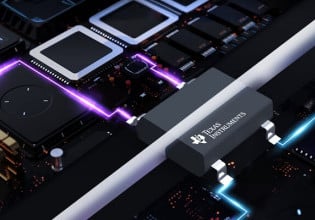Panasonic Corporation has developed an all-integrated power converter that allows the power switches to be controlled by microwave signals. The world's first microwave-controlled power converter consists of an integrated matrix-converter power switching chip that directly converts ac power to ac of the desired frequency and amplitude, and a gate drive transmitter chip that controls the power switching chip. As a result, the new converter, which is one-hundredth of the size of conventional power converters, realizes reduction of conversion power loss.
Motor-driven equipment mostly uses power conversion systems with an inverter to save power. As those systems are composed of large-size discrete components, they cannot be installed in a compact system. The new ultra compact power converter consists of a GaN-based bi-directional power switching chip and a microwave gate drive transmitter chip, enabling to integrate a motor and its drive system. Further, it is maintenance-free because it does not require discrete components that can limit the life span of the system.
Panasonic's new power converter, which uses the company's own Drive-by-microwave® technology, has the following distinctive features: By integrating two types of chips, GaN bi-directional power switches and isolated gate drivers using a microwave wireless power transmission, the ultra-compact power converter is realized. In comparison with the conventional inverter-based ac-ac power conversion system, the new power converter achieves lower power conversion loss and longer life due to the absence of an electrolytic capacitor.
To achieve the new power converter, Panasonic has developed the following new technologies: Matrix converter technology with GaN bi-directional power switches. Drive-by-microwave® technology, which makes a power switch ON and OFF by a microwave wireless power transmission. Integration technology of GaN power device and microwave wireless power transmission circuit.
Conventional power converter systems using an inverter have close to 10% power conversion loss during the ac-to-dc conversion and the subsequent dc-to-ac conversion. The one-chip integration of the conventional isolated gate drivers for power switches' control has been impossible because the conventional driver uses a bulky isolated power supply and a photo-coupler. Panasonic released further discussion of the technology in the following three areas:
1) Matrix converter technology with GaN bi-directional power devices: In order to efficiently rotate an ac motor with the variable speeds and torques, the power conversion with desired frequency and amplitude from ac power source is essential. Conventional power conversion systems using an inverter can realize an ac-to-ac power conversion by changing ac-to-dc first and then change dc-to-ac. However, there are many problems with those systems, such as large power conversion loss in the multi-step conversion, short life-time attributable to the use of large-size electrolytic capacitors, and large-size system due to an additional power factor control circuit and DC reactor.
On the other hand, since the matrix power converter that can directly convert ac-to-ac power consists of only power switches, it reduces its power conversion loss and simplifies its system configuration. Moreover, the further low power conversion loss is achieved because the new system employs the low-loss GaN bi-directional power switch. And the GaN bi-directional power switch that can control bi-directional switching operation with one device contributes to the drastic downsizing of the power conversion system.
2) Panasonic's Drive-by-microwave® technology, which turns the GaN bi-directional power devices ON and OFF by microwave wireless power transmission: The isolated coupler using wireless power transmission based on an electro-magnetic resonant coupling can be made smaller in size when it is designed at higher frequency. Then, this can be applied in semiconductor based devices by using microwaves (5GHz). Because this electro-magnetic resonant coupling conveys signal power with high efficiency over a long distance, the coupler can realize a very high dc isolation voltage such as 9.6kV. The Drive-by-microwave® technology that controls the power switch by microwave wireless power transmission is Panasonic's unique driving technology, which is the fusion of RF and power electronics.
The newly-developed isolated dividing coupler duplicates two isolated signals from an input signal by the vertically stacked 3 resonators. This reduces the gate control lines by half and leads to drastic downsizing of the system, as the system is simplified with fewer drivers. The one-chip driver constructed of GaN high-frequency devices can reduce the driving power consumption to about one-third of conventional power supply technologies because of the signal power sharing, while the conventional power supply technologies required large power consumption by 18 isolated supplies.
3) Integration technology of the GaN power device and microwave wireless power transmission circuit: Because a conventional Si-based power switch has a vertical structure, the current flows from the top to the bottom in the substrate, so that the integration of multi-switches into a one chip is impossible. Since the GaN power switch has a lateral structure, the integration of the multi power switches can be realized with a simple device isolation process technology. Therefore, the extreme downsizing of the power convertor system is achieved by using the nine GaN bi-directional power switches integration chip. A part of the microwave wireless power transmission circuit is integrated into the integration chip.






